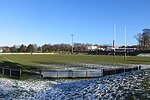Craig House, Edinburgh
Category A listed buildings in EdinburghDefunct hospitals in ScotlandEdinburgh Napier UniversityFormer psychiatric hospitals in ScotlandHistory of Edinburgh ... and 2 more
Reportedly haunted locations in EdinburghUse British English from January 2015

Craig House is a historic house and estate located on Easter Craiglockhart Hill, between the Craiglockhart and Morningside areas of Edinburgh, Scotland. Old Craig House dates from the 16th century, and succeeded an earlier building. In the late 19th century it was purchased by the Royal Edinburgh Hospital, and the site was developed as Craig House Hospital, a psychiatric hospital, including substantial new buildings. Following refurbishment, the site was opened in 1996 as the Craighouse Campus of Edinburgh Napier University.
Excerpt from the Wikipedia article Craig House, Edinburgh (License: CC BY-SA 3.0, Authors, Images).Craig House, Edinburgh
Sassoon Grove, City of Edinburgh Craiglockhart
Geographical coordinates (GPS) Address External links Nearby Places Show on map
Geographical coordinates (GPS)
| Latitude | Longitude |
|---|---|
| N 55.923055555556 ° | E -3.2280555555556 ° |
Address
Craig House
Sassoon Grove
EH10 5FB City of Edinburgh, Craiglockhart
Scotland, United Kingdom
Open on Google Maps








